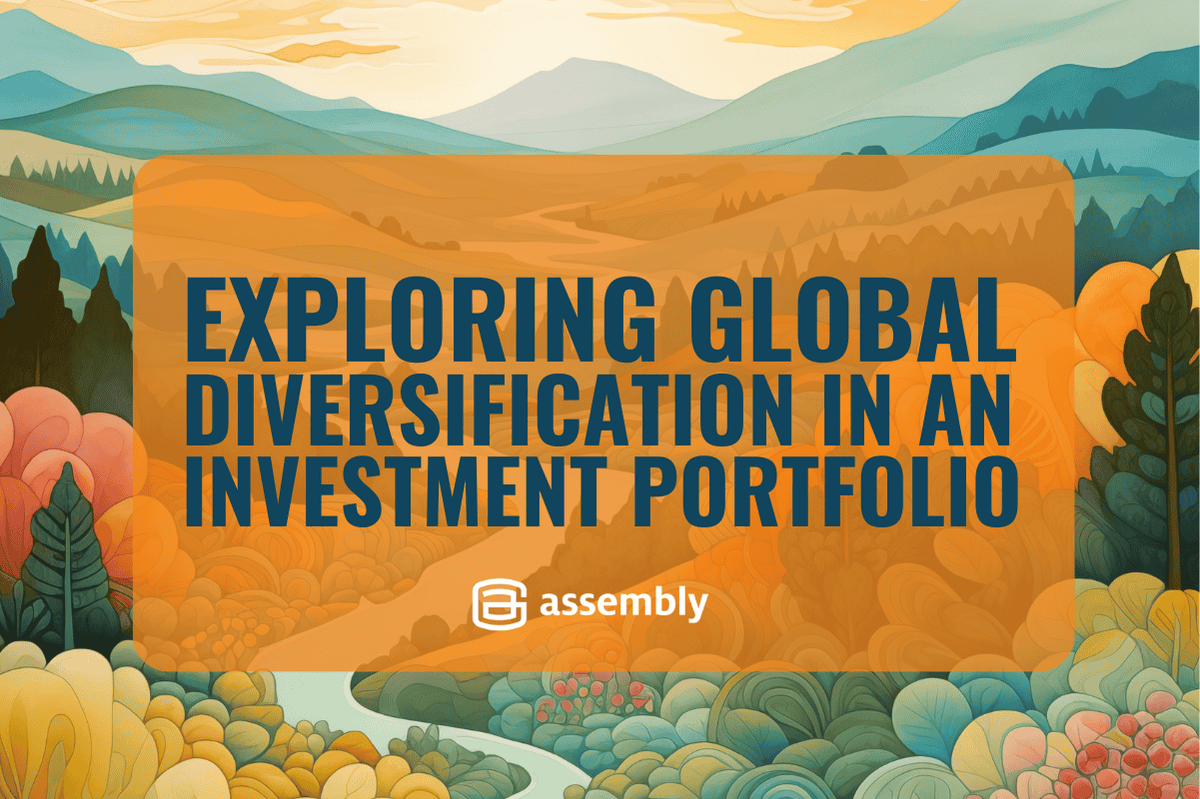The Benefits of Diversification and How To Diversify Your Portfolio
Diversification is one of the most effective strategies for managing risk and improving long-term investment outcomes. By choosing investments across...
4 min read
 Doug Hutchinson
:
May 9, 2025 7:42:55 AM
Doug Hutchinson
:
May 9, 2025 7:42:55 AM

When it comes to investing, most people gravitate to companies they know and trust. This tendency leads many Americans to primarily invest in U.S.-based companies. While familiarity can feel comfortable, concentrating solely on U.S. stocks may limit diversification, which is a key consideration in managing overall portfolio risk.
Including investments from a range of international markets can help broaden exposure and provide access to different economic environments. While no approach guarantees success or prevents loss, expanding beyond domestic holdings may offer additional opportunities. The charts below highlight trends and insights related to the potential benefits of global diversification.
The U.S. stock market has done well over the past 15 years, but it hasn't always been the best performer worldwide. No single country stays at the top every year. Markets change, economies go through cycles, and different countries take the lead - often in ways we can't predict.
The chart below shows yearly returns from different countries' stock markets. Notice how countries frequently change places.
In the last fifteen years, the U.S. (shown in very light green, almost white) has often ranked among the top five countries, but sometimes it falls near the bottom. By spreading your investments across multiple countries, you can help balance your portfolio. When U.S. stocks are down, international stocks might be up, which can help reduce the overall ups and downs in your investment returns.
Click image to see graph enlarged.
SOURCE: Novel Investor, MSCI USA Index
From 2000 to 2010, often called the "lost decade," the S&P 500 actually lost money overall. However, investors who spread their money across different countries didn't suffer as much. Their investments were helped by gains from countries rich in natural resources like Australia, Brazil, and Canada. These countries did much better than the U.S. during the boom in commodity prices. Developing countries, called emerging markets, also had a period of very strong performance.
The graph below shows times when European, Australian, and Asian stock markets (as seen in the MSCI EAFE index*) did better than the U.S. stock market (MSCI USA index**). This is another example of how different regions take turns leading in performance over time.
Click image to see graph enlarged.
SOURCE: oppenheimer.com
Putting all your money in one market, even if it has done well in the past, means your investments will rise or fall based only on that economy's performance. By spreading your investments across different countries and industries, you lower your overall risk.
Taking out just one company can really change how we see the market's performance. If we rewind to the lowest point in 2022 and remove Nvidia (NVDA) from the S&P 500, the U.S. stock market's results look very different.
In the line graph below, the grey line shows the S&P 500 without Nvidia. Without Nvidia's dramatic rise, U.S. stocks would actually have performed worse than both Japanese stocks (shown in blue) and European stocks (shown in green).
Click image to see graph enlarged.
SOURCE: JPMorgan Guide to the Markets
Where will the next innovative, fast-growing company come from? As the graph on the left shows, more than half of the top 50 global performers, on average, come from outside the U.S. When you have a globally diversified portfolio, you don’t have to guess where the next breakout star will be — you’re already invested.
Adding international investments isn't about trying to pick which country will do best next. There will always be investments you wish you had made when looking back, as the graphs below clearly show. The real goal is to keep at least some of your money spread across the world for the long term.
Click image to see graph enlarged.
SOURCE: Vanguard
Yes, there will be times when international stocks do worse than U.S. stocks, but history shows these periods are often followed by strong comebacks. Instead of trying to predict these changes, spreading your investments globally can prepare your portfolio ahead of time.
An internationally diversified portfolio isn’t a bet against the United States. Instead, it's about creating a portfolio that can withstand varying economic cycles, policy changes and national trends.
Here are two important points to consider:
A simple way to reduce concentration risk is to take a more global approach to investing. This means choosing investments that better match the actual makeup of the world economy.
Click image to see graph enlarged.
SOURCE: JPMorgan Guide to the Markets 3-31-2025
At Assembly Wealth, we can help you construct a balanced portfolio — not just within a single market but across the globe. If you'd like to discuss how global diversification aligns with your financial goals, we're here to provide personalized guidance. Contact us online or give us a call at (415) 541-7774.
* The MSCI EAFE Index (Europe, Australasia, and Far East) is designed to measure the performance of large- and mid-cap equities across 21 developed markets, excluding the U.S. and Canada. It represents a broad and diversified set of international equities, covering approximately 85% of the free float-adjusted market capitalization in each country included.
** The MSCI USA Index is designed to measure the performance of the large- and mid-cap segments of the U.S. equity market. With over 600 constituents, the index covers approximately 85% of the free float-adjusted market capitalization in the United States. It is maintained by MSCI Inc., a leading provider of global equity indexes. The MSCI USA Index is widely used as a benchmark for U.S. equity portfolios and investment strategies.
Related Reading:
Disclaimer:
International investing involves additional considerations compared to U.S.-only strategies. These include currency exchange risk, which can affect the value of foreign investments as exchange rates fluctuate. Other factors—such as differing regulations, geopolitical risks, and market structures — may also impact performance. Past performance is not indicative of future results, and diversification does not ensure a profit or protect against loss.
Assembly Wealth (“Assembly”) is an SEC registered investment adviser; however, this does not imply any level of skill or training and no inference of such should be made. The opinions expressed herein are as of the date of publication and are provided for informational purposes only. Content will not be updated after publication and should not be considered current after the publication date. We provide historical content for transparency purposes only. All opinions are subject to change without notice and due to changes in the market or economic conditions may not necessarily come to pass. Mention of a security should not be considered a recommendation or solicitation to purchase or sell the security, and any securities mentioned may be held by Assembly for client portfolios.
Information presented represents an opinion as of the date published and should not be considered an investment recommendation. Assembly does not become a fiduciary to any listener, reader or other person or entity by the person’s use of or access to the material. The reader assumes the responsibility of evaluating the merits and risks associated with the use of any information or other content and for any decisions based on such content.
Fill out the form to be notified about new articles.

Diversification is one of the most effective strategies for managing risk and improving long-term investment outcomes. By choosing investments across...

Nvidia’s market cap reached $3.3 trillion in mid-June, briefly eclipsing Microsoft as the largest publicly traded company in the world. When thinking...

With the year coming to a close, now is a good time to do an annual review of your financial health. Here are 10 financial planning items to review...